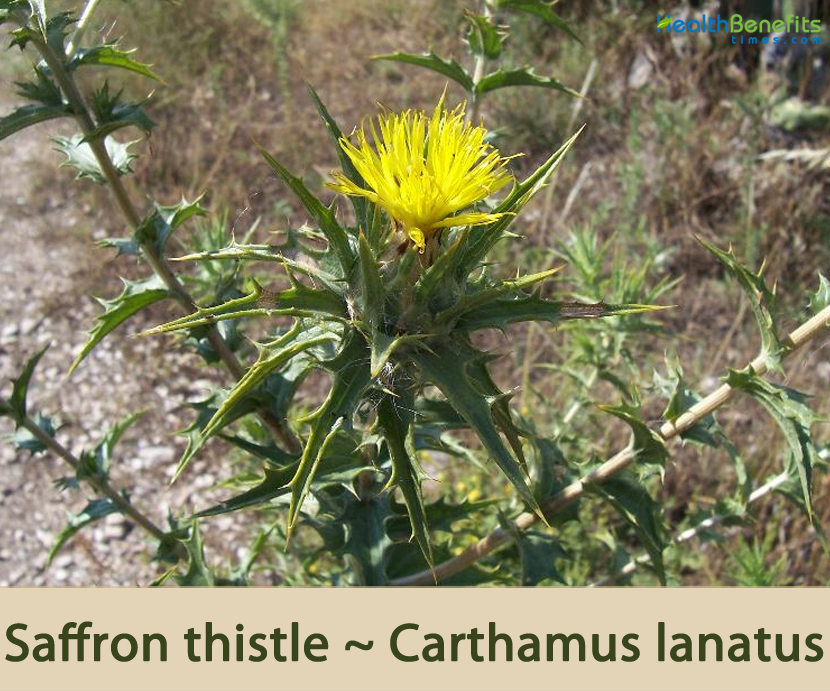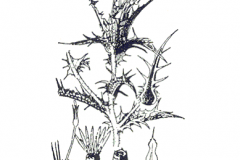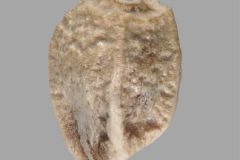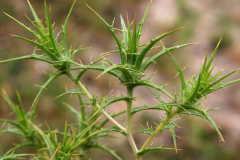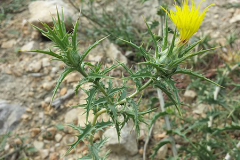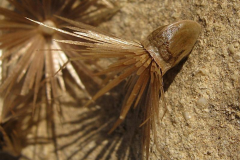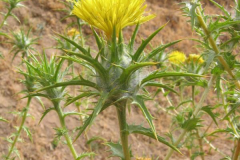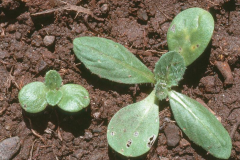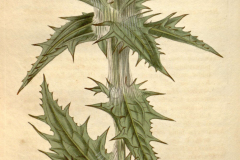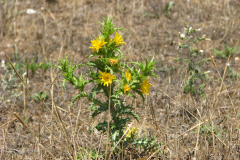| Saffron thistle Quick Facts | |
|---|---|
| Name: | Saffron thistle |
| Scientific Name: | Carthamus lanatus |
| Origin | Native to the Western Asia, southern Europe and Mediterranean region |
| Colors | Initially green turning to brown to greyish as they mature |
| Shapes | Achene (cypsela) that looks like a shuttlecock about 5-8 mm long. |
| Name | Saffron thistle |
|---|---|
| Scientific Name | Carthamus lanatus |
| Native | Native to the Western Asia, southern Europe and Mediterranean region (i.e. Egypt, Turkey, Czechoslovakia, Hungary, Switzerland, western Russia, Ukraine, Albania, Bulgaria, Greece, Romania, Yugoslavia, France and Portugal) |
| Common Names | Distaff thistle, downy safflower, saffron thistle, smooth distaff thistle, woolly distaff thistle, woolly safflower, woolly star thistle, woolly thistle, yellow star thistle, Zafferanone selvatico, false star thistle, True Star Thistle, Luddsafflor, Wollige Saffloer, Wolliger Saflor, Cardo-da-cruz, Cardo-do-diabo, Cardo-lanudo, Wolliger Saflor, Barnaby Thistle, Chinese Thistle, Common Star Thistle, Distaff, Saffron Star Thistle, Star Thistle, Sulphur Thistle, Woolly Kentrophyllum, Yellow Chinese Thistle |
| Name in Other Languages | Albanian: Kartam, kartami leshatak Arabic: shawarib eantar (shawarib eantr) (شوارب عنتر (شوارب عَنتر)), Shuk eantar (shuk eantar) (شوك عنتر (شوك عَنْتَر)), qurtum sufi (قرطم صوفي) Azerbaijani: Tüklü ulaxqanqalı Brazil: Cardo-lanudo Bulgarian: Vŭlnest aspurt (вълнест аспурт), zhŭlt aspurt (жълт аспурт), zhŭltotsveten asprut (жълтоцветен аспрут) Catalan: Assotacristos, card fuell, card sant Chinese: Máohónghuā (毛红花 ) Croatian: Vunenasti bodalj Czech: Světlice vlnatá Danish: Ulden farvetidsel, Håret saflortidsel Dutch: Wollige safflower, wollige saffloer English: Saffron thistle, Woolly safflower , downy safflower, woolly distaff thistle, distaff thistle, Woolly star thistle, Woolly thistle, Yellow star thistle, False star thistle, True Star Thistle Finnish: Villasaflori French: Carthame, Carthame laineux, centrophylle laineuse, chardon béni des Parisiens, chardon bénit des Parisiens, faux saf Galician: Cártamo silvestre German: Wolliger Saflor, Saflor, wollige Saflor, wolliges Spornblatt, Wolliger Saflor, W. Färberdistel, Wollige Färberdistel Greek: Atraktýli (ατρακτύλι), kárthamos o eriódis (κάρθαμος ο εριώδης), kárthamos o mallotós (κάρθαμος ο μαλλωτός) Hungarian: Vadpórsáfrány Italian: Cartamo lanoso, Zafferanone selvatico, scardiccione salvatico Japanese: Arechibenibana (アレチベニバナ) Kabyle: Ḥasek Latvian: Villainais saflors Persian: گلرنگ زعفرانی Polish: Kartamus barwierski, Krokosz błękitny Portuguese: Cardo sanguinho, cardo-da-cruz, cardo-do-diabo, cardo-lanudo, cardo-beija-mão, cardo-cristo, cártamo-lanoso, Romanian: Pintenoagă, pintenoagă lînata Russian: Saflor sherstistyy (сафлор шерстистый) Serbian: Bodal̂ (бодаљ), boden (боден), vunasta shafranka (вунаста шафранка), obični bodalj (обични бодаљ) Slovak: Požlť vlnatý Slovene: Volnati rumenik Spanish: Cardo lanudo, cardilla, espinas de cristo, azotacristos, cardo cabrero, cardo chico, cardo de Cristo, cardo hueso , cardo lanudo, cardones, cártamo salvaje, cártamo Silvestre, espinas de Cristo, pincho cambrón, sangre de Cristo, cardo del Diablo, Cardo-chileno, Cardo-cruz, Cardo-del-diablo, Cardo-lanudo, Cartamo, Manca-potrillo Swedish: Luddsafflor Turkish: Sarıdiken Ukrainian: Saflor sherstistiy (сафлор шерстистий) Welsh: Cochlys Gwlanog, Safflwr Gwlanog |
| Plant Growth Habit | Erect, spiny, glandular, woolly winter annual plant |
| Growing Climates | Roadsides, pastures, waste land, arable land, river flats, fowl runs, railway ballast, woodland, dry hills, uncultivated ground, disturbed open sites, fields, annual grasslands and sometimes agricultural land, especially grain fields |
| Soil | Under high fertility conditions other plants tend to displace Saffron Thistle, so it is more abundant on the less fertile soils. It has no particular affinity for soil types, but tends to be less common on the sands and in WA is most abundant on the red clays. It is most common on disturbed loamy and clayey soils in NSW, and generally prefers cultivated or disturbed soils elsewhere |
| Plant Size | Up to 3.3 ft. (1 m) tall |
| Root | Roots are simple, unbranched taproots with numerous fibrous secondary roots |
| Stem | Stems are rigid, ribbed, white-yellowish white, but may be pale green in color, usually with minute hairs, but some plants are wooly. Stems do not have the wings that are prominent on Italian and slender flower thistles |
| Leaf | Rosette leaves (a cluster of leaves at the base of a plant often lying flat against the ground) are up to 20 cm long and to 5 cm wide. They are deeply divided with broad terminal lobes, each lobe ending in a spine. Stem leaves are 11 cm long and to 5 cm wide, spreading or recurved, lance shaped to ovate, alternate, shorter, reflexed (turned abruptly backwards or downwards) and very rigid. |
| Flowering season | July through August |
| Flower | Flowering heads usually 25-35 mm long are made up of many yellow or cream florets (an individual flower usually small, forming part of a group of flowers arising from one stem) with faint red or black veins. The flower heads are solitary at the end of branches. |
| Fruit Shape & Size | Achene (cypsela) that looks like a shuttlecock about 5-8 mm long |
| Fruit Color | Initially green turning to brown to greyish as they mature |
| Propagation | By seed |
| Traditional Medicinal Use |
|
| Culinary uses |
|
| Other Facts |
|
Plant Description
Saffron Thistle is an erect, spiny, glandular, woolly winter annual plant that normally grows up to 3.3 ft. (1 m) tall. The plant is found growing in roadsides, pastures, waste land, arable land, river flats, fowl runs, railway ballast, woodland, dry hills, uncultivated ground, disturbed open sites, fields, annual grasslands and sometimes agricultural land, especially grain fields. Under high fertility conditions other plants tend to displace Saffron Thistle, so it is more abundant on the less fertile soils. It has no particular affinity for soil types, but tends to be less common on the sands and in WA is most abundant on the red clays. It is most common on disturbed loamy and clayey soils in NSW, and generally prefers cultivated or disturbed soils elsewhere. Roots are simple, unbranched taproots with numerous fibrous secondary roots.
Stem
Stem is unbranched on the lower third and extensively branched on the upper two thirds. Stems are rigid, ribbed, white-yellowish white, but may be pale green in color, usually with minute hairs, but some plants are wooly. Stems do not have the wings that are prominent on Italian and slender flower thistles.
Leaves
Leaves arise from the base and also on the stem. The rosette leaves (a cluster of leaves at the base of a plant often lying flat against the ground) are up to 20 cm long and to 5 cm wide. They are deeply divided with broad terminal lobes, each lobe ending in a spine. Stem leaves are 11 cm long and to 5 cm wide, spreading or recurved, lance shaped to ovate, alternate, shorter, reflexed (turned abruptly backwards or downwards) and very rigid. They are prominently veined, lobed and spiny and are stem clasping; usually without hairs or sparsely downy on the upper surface.
Flowers
Flowering heads usually 25-35 mm long are made up of many yellow or cream florets (an individual flower usually small, forming part of a group of flowers arising from one stem) with faint red or black veins. The flower heads are solitary at the end of branches. The florets are surrounded by stiff, spiny, leaf-like, hairy bracts (a small leaf-like appendage or scale which is immediately below a flower or inflorescence) that are 3-5cm long. The flowers are hermaphrodite (has both male and female organs) and are pollinated by Insects. Flowering normally takes place in between July through August.
Fruit
Fertile flowers are followed by Achene (cypsela) that looks like a shuttlecock about 5-8 mm long. They are initially green turning to brown to greyish as they mature. They are 4 ribbed and sometimes wrinkled or pitted near the top. The 4 angled bases are about 3 mm long and surmounted by a fringe of semitransparent scales.
Seeds
Seeds are grey brown, 4 angled; egg to wedge shaped, smooth 4-6 mm long, about 3 mm wide and hairless. Some have a pappus of several rows of stiff bristles of uneven lengths up to 10 mm long.
Weed management
Saffron thistle plant can be controlled using a range of herbicides. Several biological control options have been investigated for Australia, including classical biological control, although finding an insect or fungus that will not also attack safflower has proven difficult. A rosette-feeding fly Botanophila turcica shows some promise. The potential for using pathogens already present in Australia has also been investigated.
In pastures, good pasture cover in autumn will reduce germination, suggesting that pastures should be managed to reduce grazing pressure over summer, and increase the cover from summer-growing perennial grasses. Population models suggest that strategic grazing may be one of the most effective long-term control options for infested pastures.
Different Control Methods
Production and spread of seeds must be halted. Isolated plants should be killed with an herbicide or cut just below the soil and removed from the field. Mowing is effective if done just prior to flower-bud formation. If mowed too early, the plants regrow from the base and produce new flower stems. If left until flowering, there may be enough food material in the cut stems to allow the seeds to mature.
Heavy grazing of a pasture encourages distaff thistle because the leaves of the flat and spiny rosettes are difficult to graze. Most other plants are grazed first, leaving distaff thistle with little competition. Invasion by distaff thistle is most likely in areas where the soil has been disturbed or the pasture weakened by overgrazing. Distaff thistle does not readily attack well-managed perennial pastures but quickly becomes established in any cropping system that leaves small sites between plants unoccupied in fall and early winters.
Several common broadleaf herbicides control distaff thistle when applied to seedlings or rosettes. Control is more difficult as plants mature. Any control programs must include the establishment and care of a vigorous crop to resist further invasion by distaff thistle.
Since herbicide registrations change frequently, resulting in more or fewer available herbicides and changes in permissible herbicide practices, this publication doesn’t make specific herbicide recommendations.
For current recommendations, refer to the Pacific Northwest Weed Control Handbook, published and revised annually by the Extension Services of Oregon State University, Washington State University, and the University of Idaho.
References:
https://www.itis.gov/servlet/SingleRpt/SingleRpt?search_topic=TSN&search_value=501303#null
http://www.hear.org/pier/species/carthamus_lanatus.htm
https://npgsweb.ars-grin.gov/gringlobal/taxon/taxonomydetail?id=9235
https://pfaf.org/user/Plant.aspx?LatinName=Carthamus+lanatus
https://www.cabi.org/isc/datasheet/90036849
https://en.wikipedia.org/wiki/Carthamus_lanatus
https://www.flowersofindia.net/catalog/slides/Saffron%20Thistle.html
http://www.theplantlist.org/tpl1.1/record/gcc-77840
https://indiabiodiversity.org/species/show/229074?lang=en
https://keyserver.lucidcentral.org/weeds/data/media/Html/carthamus_lanatus.htm
https://www.oregon.gov/oda/shared/Documents/Publications/Weeds/WoollyDistaffThistleProfile.pdf
https://www.invasive.org/browse/subinfo.cfm?sub=5240
http://www.worldfloraonline.org/taxon/wfo-0000116437
https://gd.eppo.int/taxon/CAULA
https://caws.org.nz/PPQ1819/PPQ%2019-1%20pp036-39%20Grace.pdf
https://plants.usda.gov/home/plantProfile?symbol=CALA20


